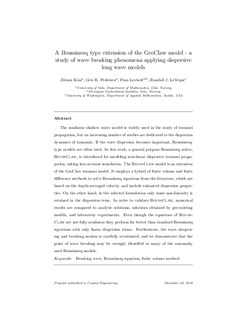| dc.description.abstract | The nonlinear shallow water model is widely used in the study of tsunami propagation, but an increasing number of studies are dedicated to the dispersion dynamics of tsunamis. If the wave dispersion becomes important, Boussinesq-type models are often used. In this work, a general purpose Boussinesq solver, BoussClaw, is introduced for modeling non-linear dispersive tsunami propagation, taking into account inundation. The BoussClaw model is an extension of the GeoClaw tsunami model. It employs a hybrid of finite volume and finite difference methods to solve Boussinesq equations from the literature, which are based on the depth-averaged velocity and include enhanced dispersion properties. On the other hand, in the selected formulation only some non-linearity is retained in the dispersion term. In order to validate BoussClaw, numerical results are compared to analytic solutions, solutions obtained by pre-existing models, and laboratory experiments. Even though the equations of BoussClaw are not fully nonlinear they perform far better than standard Boussinesq equations with only linear dispersion terms. Furthermore, the wave steepening and breaking are carefully scrutinized, and we demonstrate that the point of wave breaking may be wrongly identified in many of the commonly used Boussinesq models. | |
